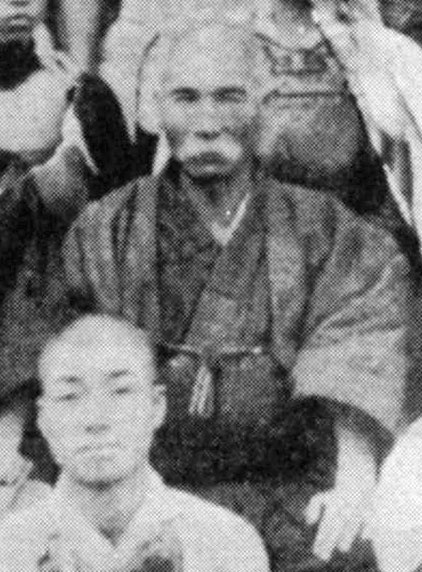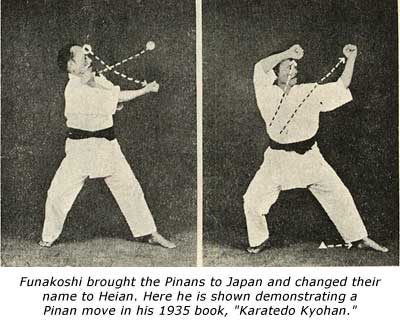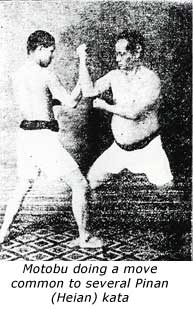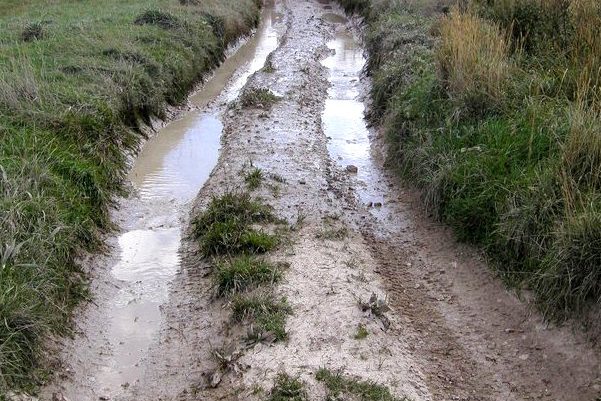When the legendary Winston Churchill once described Russia as “a riddle wrapped in a mystery inside an enigma”, some people could swear he was actually talking about a Karate kata named Channan.
…chan-what, now?
Channan.
Never heard of it before?
Don’t worry, most people haven’t.
See, in Karate, as in many areas of life, there’s still some unresolved mysteries hanging around from old times. Mysteries that have eluded researchers for ages, even eventually spawning all kinds of wacky articles and books from confused “experts”-turned-authors who desperately seek to gain some attention as they believe to have once and for all found the solution to any of these puzzling Karate mysteries out there.
And one of the biggest mysteries in Karate goes by the name of Channan – an allegedly “lost” kata that once supposedly was something of a traditional pillar in old-school Okinawan Karate.
Is that the case?
Is there really a lost, secret, kata by the name of Channan that would open up some kind of Pandora’s box to understanding Karate’s roots?
Dang, I don’t know.
But my colleague Joe Swift, of Tokyo Mushinkan, once wrote a terrific article summing up most of the relevant translated research related to the topic, and it would be a shame to not give you guys the opportunity to read this epic piece of Channan-debunking work.
So, without further ado, let’s see what this “Channan” issue is all about, shall we? Joe-san, the floor is all yours.
Let’s go:
Channan: The “Lost” Kata of Itosu?

By Joe Swift
Introduction
The series of five basic kata called Pinan (later renamed Heian in Japan) are probably the most widely practiced kata in karate today. It is commonly understood that they were developed by Anko (or Yasutsune) Itosu (1832-1915) in around 1907 for inclusion in the karate curriculum of the Okinawan school system. However, the actual history of the Pinan series has been the subject of intense curiosity as of late. There are basically two schools of thought, one that Anko Itosu (1) developed them from the older classical forms that were cultivated in and around the Shuri (capital of Okinawa) area, and the other that Itosu was re-working a longer Chinese form called Channan.
Unfortunately, most of the written references to the Channan/Pinan phenomenon in the English language are basically re-hashes of the same uncorroborated oral testimony. This article will examine the primary literature written by direct students of Itosu, as well as more recent research in the Japanese language, in an effort to solve the “mystery” of Channan.
Anko Itosu
In order to understand the Pinan phenomenon, perhaps it is best to start off with a capsule biography of their architect, Anko Itosu (1832-1915). Many sources state that Itosu was born in the Yamakawa section of Shuri (Bishop, 1999; Okinawa Prefecture, 1994; Okinawa Prefecture, 1995), however, noted Japanese martial arts historian Tsukuo Iwai states that he was actually born in Gibo, Shuri, and later relocated to Yamakawa (Iwai, 1992). He is commonly believed to have studied under Sokon (“Bushi”) Matsumura (1809-1901), but also appears to have had other influences, such as Nagahama of Naha (Iwai, 1992; Motobu, 1932), Kosaku Matsumora of Tomari and a master named Gusukuma (Nihon Karate Kenkyukai, 1956).
There does not seem to be much detail about Itosu’s early life, except for the fact that he was a student of the Ryukyuan civil fighting traditions. At around age 23, he passed the civil service examinations and was employed by the Royal government (Iwai, 1992). It seems as if Itosu gained his position as a clerical scribe for the King through an introduction by his friend and fellow karate master Anko Asato (Funakoshi, 1988). Itosu stayed with the Royal government until the Meiji Restoration, when the Ryukyu Kingdome became Okinawa Prefecture. Itosu stayed on and worked for the Okinawan Prefectural government until 1885 (Iwai, 1992).
There is some controversy as to when Itosu became a student of Matsumura. Some say that he first met Matsumura when Itosu was in his late 20s (Iwai, 1992), whereas others maintain that Itosu was older than 35 when he began studying from Matsumura (Fujiwara, 1990). Matsumura appears to have been friendly with Itosu’s father (Iwai, 1992).

Be that as it may, Itosu is said to have mastered the Naifuanchi kata (Nihon Karate Kenkyukai, 1950; Okinawa Pref., 1995). In fact, one direct student of Itosu, namely Funakoshi Gichin, recalled 10 years of studying nothing but the three Naifuanchi kata under the eminent master (Funakoshi, 1976) (2).
Again, there is some controversy as to where Itosu learned the Naifuanchi kata. Some give credit to Matsumura for teaching this kata to Itosu (Murakami, 1991). However, others say differently, and here is where we first start to see reference to Channan, as the name of a person. It is said that a Chinese sailor who was shipwrecked on Okinawa hid in a cave at Tomari. It was from this man that Itosu supposedly learned the Naifuanchi kata, among other things (Gima, et al, 1986).
In either case, it is known that Itosu was among the first to teach karate (toudi) publicly, karate having previously been taught and practiced in secrecy for hundreds of years. Itosu began his public teaching pf karate as physical education in the school system as early as 1901, where he taught at the Shuri Jinjo Primary School (Iwai, 1992; Okinawa Pref., 1994). He also went on to teach at Shuri Dai-ichi Middle School and the Okinawa Prefectural Men’s Normal School in 1905 (Bishop, 1999; Okinawa Pref., 1994, 1995).
In addition to his “spearheading a crusade” (McCarthy, 1996) to modernize toudi practices and get it taught in the school system, Itosu was also known for his physical strength. It is said that he was able to crush a bamboo stalk in his hands (Funakoshi, 1976, 1988), once wrestled a raging bull to the ground and calmed it (Nagamine, 1986) and one could strike his arms with 2-inch thick poles and he would not budge (Iwai, 1992).
Itosu’s unique contributions to the art of Karate-do include not only his 1908 letter to the Japanese Ministry of Education and Ministry of War (3), expounding on the 10 precepts of Toudi training, but also the creation of several kata. These include not only the Pinan series, but also Naifuanchi Nidan and Sandan (Kinjo, 1991; Murakami, 1991), and possibly Kusanku Sho and Passai Sho (Iwai, 1992). Another kata that has often been attributed to Itosu is the Shiho Kusanku Kata (Kinjo, 1956a; Mabuni et al, 1938), but more recent evidence points to the actual originator of this paradigm to have been Mabuni Kenwa himself (Sells, 1995).
In addition to creating several kata, the other kata that Itosu taught, such as Chinto, Useishi (Gojushiho), Passai Dai, and Kusanku Dai, etc., were changed from their original guises, in order to make them more palatable to his physical education classes (Kinjo, 1991).
Itosu Anko passed away in March 1915, leaving behind a legacy that very few today even recognize or comprehend.
Early Written References to Channan and Pinan
References to Channan can be found as far back as 1934. In the karate research journal entitled Karate no Kenkyu, published by Nakasone Genwa, Motobu Choki is quoted referring to the Channan and the Pinan kata:
 “(Sic.) I was interested in the martial arts since I was a child, and studied under many teachers. I studied with Itosu Sensei for 7-8 years. At first, he lived in Urasoe, then moved to Nakashima Oshima in Naha, then on to Shikina, and finally to the villa of Baron Ie. He spent his final years living near the middle school.
“(Sic.) I was interested in the martial arts since I was a child, and studied under many teachers. I studied with Itosu Sensei for 7-8 years. At first, he lived in Urasoe, then moved to Nakashima Oshima in Naha, then on to Shikina, and finally to the villa of Baron Ie. He spent his final years living near the middle school.
I visited him one day at his home near the school, where we sat talking about the martial arts and current affairs. While I was there, 2-3 students also dropped by and sat talking with us. Itosu Sensei turned to the students and said ‘show us a kata.’ The kata that they performed was very similar to the Channan kata that I knew, but there were some differences also. Upon asking the student what the kata was, he replied ‘It is Pinan no Kata.’ The students left shortly after that, upon which I turned to Itosu Sensei and said ‘I learned a kata called Channan, but the kata that those students just performed now was different. What is going on?’ Itosu Sensei replied ‘Yes, the kata is slightly different, but the kata that you just saw is the kata that I have decided upon. The students all told me that the name Pinan is better, so I went along with the opinions of the young people.’ These kata, which were developed by Itosu Sensei, underwent change even during his own lifetime.” (Murakami, 1991; 120)
There is also reference to Pinan being called Channan in its early years in the 1938 publication Kobo Kenpo Karatedo Nyumon by Mabuni Kenwa and Nakasone Genwa. Mabuni and Nakasone write that those people who learned this kata as Channan still taught it under that name (Mabuni, et al, 1938).
Hiroshi Kinjo , one of Japan’s most senior teachers and historians of the Okinawan fighting traditions, and a direct student of three of Itosu’s students, namely Chomo Hanashiro, Chojo Oshiro, and Anbun Tokuda, wrote a series of articles on the Pinan kata in Gekkan Karatedo magazine in the mid-1950s. In the first installment he maintains that the Pinan kata were originally called Channan, and there were some technical differences between Channan and the updated versions known as Pinan (Kinjo, 1956a).
Again according to Hiroshi Kinjo, Hisateru Miyagi, a former student of Itosu who graduated from the Okinawa Prefectural Normal School in 1916, stated that when he was studying under the old master, Itosu only really taught the first three Pinan with any real enthusiasm, and that the last two seem to have been rather neglected at that time (Kinjo, 1956b). Although one can speculate about what this means, it is nevertheless a very interesting piece of testimony by someone who was “there.”
Ryusho Sakagami, in his 1978 Karatedo Kata Taikan as well as Tokumasa Miyagi in his 1987 Karate no Rekishi both give extensive kata lists, and both list a kata known as Yoshimura no Channan (Miyagi, 1987; Sakagami, 1978). It is unknown who Yoshimura was, but he may have been a student of Itosu.
American karate historian Ernest Estrada has also stated that Juhatsu Kyoda (1887-1968), a direct student of Kanryo Higashionna, Xianhui Wu (Jpn. Go Kenki), Kentsu Yabu, etc. and the founder of the To’onryu karatedo system, also knew and taught a series of two basic blocking, punching and kicking exercises known as Channan (Estrada, 1998).
Shiraguma no Kata
According to Tsukuo Iwai, one of Japan’s most noted Budo researchers and teacher of Choki Motobu’s karate in Gunma Prefecture, Motoburyu Karatejutsu, which is being preserved by Choki’s son, Chosei Motobu, in Osaka, contains what is known as Shiraguma no Kata, which he maintains used to be called Channan. He also states that this kata is “somewhat similar to the Pinan, yet different.” (Iwai, 1997).
The Other Side of the Coin
The flip side to this theory states that Itosu did not create the Pinan kata, but actually remodeled older Chinese-based hsing/quan/kata called Channan. This theory states that Itosu learned a series of Chinese Quan-fa hsing from a shipwrecked Chinese at Tomari, and reworked them into five smaller components, re-naming them Pinan because the Chinese pronunciation “Chiang-Nan” was too difficult (Bishop, 1999).
It has been argued that the source for these Channan kata was a Chinese from an area called Annan, or a man named Annan (Bishop, 1999). On the other hand, others say that the man’s name was Channan (Iwai, 1992). Still others go into even more detail, stating that Itosu learned these hsing/kata from a man named Channan, and named them after their source, later adding elements of the Kusanku Dai kata to create the Pinan (Gima, et al, 1986; Kinjo. 1999).
There is also interesting oral testimony passed down in the Tomari-di tradition that is propagated in the Okinawa Gojuryu Tomaridi Karatedo Association of Iken Tokashiki that states that Itosu learned the Channan/Pinan kata from a Chinese at Tomari in one day. The proponents of Tomari-di said that there was no need to learn “over-night kata” and that this is the reason that the Tomari traditions did not include instruction in the Pinan kata (Okinawa Pref., 1995).
This sentiment also echoes the statement by one of Itosu’s top students, Yabu Kentsu, made to his students:
“(sic) If you have time to practice the Pinan, practice Kushanku instead (Gima, et al, 1986, p. 86).”
Conclusion
While more research, such as in-depth technical analysis of Motobu’s Shiraguma no Kata, needs to be done, the evidence at hand seems to point not to a “long lost kata” but rather to the constant and inevitable evolution of a martial art.
Although there is opposition, most of the primary written materials point to the fact that Itosu was indeed the originator of the Channan/Pinan tradition, based upon his own research, experience, and analyses.
However, in either case, Anko Itosu and his efforts left a lasting mark on the fighting traditions of old Okinawa, and will probably always be remembered as one of the visionaries who were able to lift the veil of secrecy that once enshrouded karatedo.
© 2000, by Joe Swift. Posted with permission of the author.
Notes:
1- Japanese names in this article are listed by given name first and family name second instead of customary Japanese usage which places the family name first.
2- According to noted Japanese martial arts historian Ryozo Fujiwara in his 1990 book entitled “Kakutogi no Rekish” (History of the Martial Arts), Funakoshi first learned Pechurin (Suparinpei) under Taite Kojo, then Kusanku under Anko Asato, and finally Naifuanchi under Itosu.
3- For a comprehensive English translation of this letter, see (McCarthy, 1990)
Bibliography:
Bishop, M. (1999) Okinawan Karate: Teachers, Styles and Secret Techniques, 2nd Edition. Boston: Charles E. Tuttle, Co.
Estrada, E. (1998). Personal Communication: Kyoda and Channan.
Fujiwara, R. (1990). Kakutogi no Rekishi (History of Martial Arts). Tokyo: Baseball Magazine.
Funakoshi G. (1976) Karatedo: My Way of Life. Tokyo: Kodansha International.
Funakoshi G. (1988) Karatedo Nyumon. Tokyo: Kodansha International. Tr. by John Teramoto.
Gima S. and Fujiwara R. (1986) Taidan: Kindai Karatedo no Rekishi wo Kataru (Talks on the History of Modern Karatedo). Tokyo: Baseball Magazine.
Iwai T. (1992). Koden Ryukyu Karatejutsu (Old-Style Ryukyu Karatejutsu). Tokyo: Airyudo.
Iwai T. (1997) Personal Communication: Shiraguma no Kata.
Kinjo A. (1999) Karate-den Shinroku (True Record of Karate’s Transmission). Naha: Okinawa Tosho Center.
Kinjo H. (1956a). “Pinan no Kenkyu (Study of Pinan) Part 1.” Gekkan Karatedo June 1956. Tokyo: Karate Jiho-sha.
Kinjo H. (1956b). “Pinan no Kenkyu (Study of Pinan) Part 2.” Gekkan Karatedo August 1956. Tokyo: Karate Jiho-sha.
Kinjo H. (1991) Yomigaeru Dento Karate 1 Kihon (Return to Traditional Karate Vol. 1, Basic Techniques) – video presentation. Tokyo: Quest, Ltd.
Mabuni K. and Nakasone G. (1938) Karatedo Nyumon (Introduction to Karatedo). Tokyo: Kobukan.
McCarthy, P. (1996) “Capsule History of Koryu Karate.” Koryu Journal Inaugural Issue. Australia, International Ryukyu Karate Research Society.
McCarthy, P. (1999) Ancient Okinawan Martial Arts: Koryu Uchinadi, Vol. 2. Boston: Charles E. Tuttle, Co.
Miyagi T. (1987) Karate no Rekishi (The History of Karate). Naha: Hirugisha.
Motobu C. (1932) Watashi no Toudijutsu (My Karate). Tokyo: Toudi Fukyukai.
Murakami K. (1991). Karate no Kokoro to Waza (The Spirit and Technique of Karate). Tokyo: Shin Jinbutsu Oraisha.
Nagamine S. (1986) Okinawa no Karate Sumo Meijin Den (Tales of Okinawa’s Great Karate and Sumo Masters). Tokyo: Shin Jinbutsu Oraisha.
Nihon Karate Kenkyukai (1956) Zoku: Karatedo Nyumon (Introduction to Karatedo: Continued). Tokyo: Wakaba Shobo.
Okinawa Prefecture Board of Education (1994). Karatedo Kobudo Kihon Chosa Hokokusho (Report of Basic Research on Karatedo and Kobudo). Naha: Nansei.
Okinawa Prefecture Board of Education (1995). Karatedo Kobudo Kihon Chosa Hokokusho II (Report of Basic Research on Karatedo and Kobudo Part II). Naha: Nanasei.
Sakagami R. (1978) Karatedo Kata Taikan (Encyclopedia of Karatedo Kata. Tokyo: Nichibosha.
Sells, J. (1995) Unante: Secrets of Karate. Hollywood: Hawley.
So what do you guys say?
To Channan or not to Channan?
Needless to say; DVDs, books and seminars have already been created around resurrecting this “lost” kata… Whatever the case though, it will probably forever remain an exciting topic of study for any Karate Nerd™ hobbyist with too much time on his/her hands.
Believe me, I know...!



17 Comments